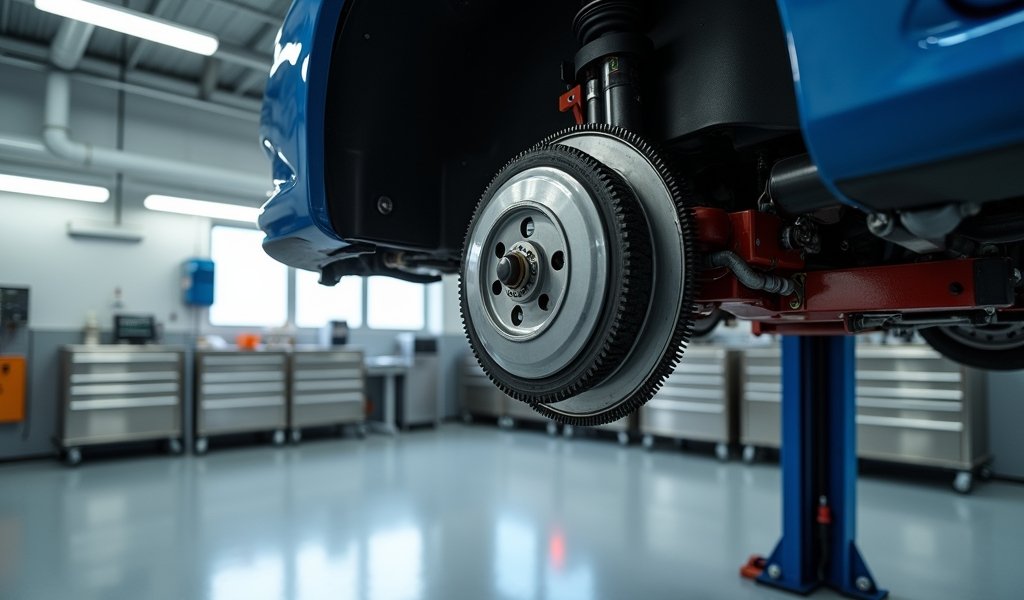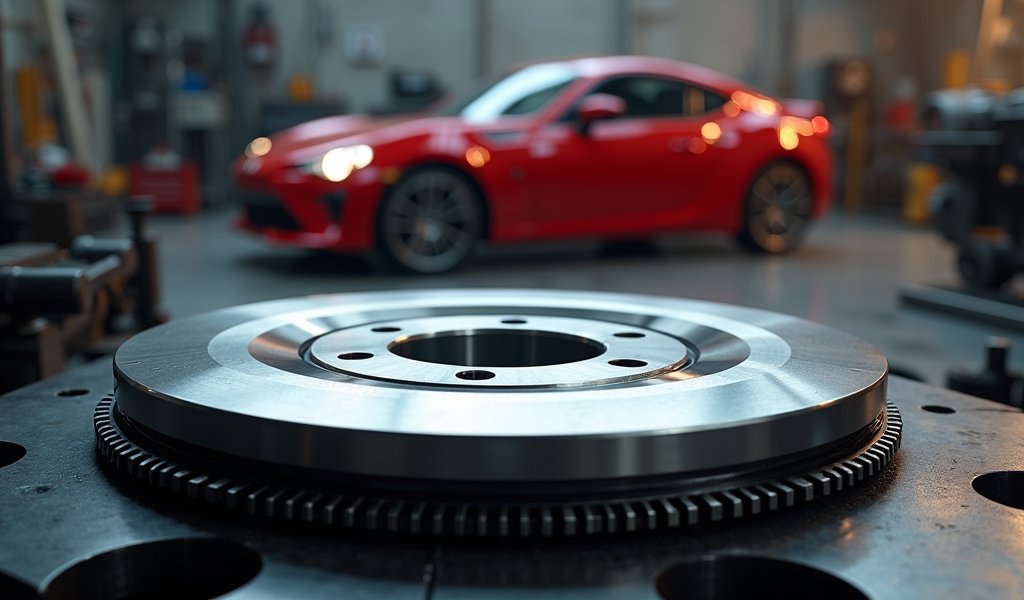Overview
This article provides a detailed guide to flywheel resurfacing, explaining how to identify when a flywheel needs resurfacing, the proper tools and techniques for removal, inspection, measurement, and reinstallation, along with critical safety considerations and break-in procedures. It emphasizes the importance of precision throughout the process and notes that proper resurfacing can significantly improve driving experience while extending clutch system life.
Table of Contents
- Understanding Flywheels: What They Do and Why They Matter
- Signs Your Flywheel Needs Resurfacing
- Tools and Equipment You’ll Need
- Step 1: Removing the Flywheel
- Step 2: Inspecting the Flywheel
- Step 3: Measuring and Evaluating
- Step 4: The Resurfacing Process
- Step 5: Reinstallation and Break-In Period
- Conclusion
- Frequently Asked Questions
Understanding Flywheels: What They Do and Why They Matter
Let’s talk shop about one of your car’s unsung heroes – the flywheel. This hefty disc might not get much attention, but it’s absolutely crucial to your vehicle’s performance. Think of it as the mechanical middleman between your engine and transmission that helps everything run smoothly.
In simple terms, your flywheel stores rotational energy from the engine and transfers it to the transmission. It’s also what your clutch grabs onto when you’re shifting gears in a manual transmission vehicle. Over time, all that grabbing and heat can take a toll on your flywheel’s surface.
The good news? You don’t need to replace your flywheel every time it shows signs of wear. With proper resurfacing, you can restore it to like-new condition and save yourself a pretty penny in the process. As a professional who’s resurfaced hundreds of flywheels, I can tell you that this procedure is absolutely worth learning if you’re serious about DIY car maintenance.
Signs Your Flywheel Needs Resurfacing
Your car has ways of telling you when the flywheel isn’t happy, and trust me – it’s better to listen sooner rather than later. Here are the telltale signs that flywheel resurfacing might be in your near future:
- Clutch chatter or vibration when engaging the clutch
- Difficulty shifting gears smoothly
- Strange noises when the clutch is engaged
- A burning smell after driving
- Clutch pedal pulsation or unusual feel
- Visible heat spots, scoring, or grooves on the flywheel surface
If you notice any of these symptoms, don’t just crank up the radio to drown them out! These problems tend to worsen over time, and that innocent vibration today could become a major transmission repair bill tomorrow. When replacing your clutch, it’s almost always a good idea to at least inspect the flywheel for potential resurfacing.
I recently helped a customer who thought he just needed new brake pads because of a “weird vibration.” Turns out, his flywheel was so badly scored that it was affecting his entire driving experience. After a proper resurfacing job following careful specifications, he couldn’t believe the difference in how his car drove.

Tools and Equipment You’ll Need
Before diving into this project, make sure you’ve got all the right tools on hand. There’s nothing more frustrating than getting halfway through a job only to realize you’re missing something essential. Here’s your flywheel resurfacing shopping list:
- Socket set and wrenches
- Torque wrench (essential for proper reinstallation)
- Flywheel locking tool
- Jack and jack stands rated for your vehicle
- Micrometer or dial indicator
- Brake cleaner and degreaser
- Shop towels and gloves
- Safety glasses
- Marker for alignment marks
- Access to a flywheel grinding machine (or a trusted machine shop)
- Your vehicle’s service manual
Don’t forget to gather all your tools before you start disassembling anything. I can’t tell you how many times I’ve seen DIYers scrambling for a specific socket while their transmission is hanging halfway out of the car. Not a good situation!
Also, while some advanced home mechanics might have their own flywheel grinding equipment, most folks will need to take the removed flywheel to a local machine shop or auto parts store that offers resurfacing services. Many larger auto parts chains provide this service for a reasonable fee.
Step 1: Removing the Flywheel
Alright, roll up those sleeves – it’s time to get to work. Removing the flywheel isn’t a quick job, so set aside a good chunk of time and make sure your vehicle is safely supported.
Start by disconnecting your battery’s negative terminal. Safety first! Next, you’ll need to access the flywheel, which means removing the transmission. This is a substantial job that varies by vehicle make and model, so consult your service manual for the specific steps for your car.
Once you’ve got the transmission out of the way and can see the flywheel, it’s time to remove the pressure plate and clutch disc. Keep track of which bolts go where – I recommend taking photos with your phone before and during disassembly.
Before removing the flywheel, make alignment marks on both the flywheel and crankshaft. This ensures you’ll install it in exactly the same position later. Don’t skip this step! Proper balance is crucial for smooth operation.
To remove the flywheel itself, you’ll need to loosen the mounting bolts. This is where your flywheel locking tool comes in handy to prevent rotation. Loosen the bolts in a star pattern, and be prepared – flywheels are heavy! Don’t let it drop when the last bolt comes out.
A word of caution: Some modern vehicles use dual-mass flywheels that have internal springs and dampeners. These typically should not be resurfaced and instead require replacement when worn. If you’re unsure if your vehicle uses this type, check with a reliable source like Motor.com’s guide to dual-mass flywheels.
Step 2: Inspecting the Flywheel
Now that you’ve got the flywheel in your hands, it’s detective time. You’re looking for several types of damage that could affect your clutch’s performance.
First, check for heat spots. These appear as blue or straw-colored discolorations on the surface and indicate overheating. Heat spots change the metal’s hardness and can cause clutch grabbing or chattering.
Next, look for scoring or grooves. Run your fingernail across the surface – if it catches in grooves, that’s a sign you need resurfacing. Think of it like running your finger across a scratched record; those grooves will affect how smoothly things play.
Check the edge of the flywheel for cracks. Even small hairline cracks are dangerous and mean the flywheel should be replaced, not resurfaced. No exceptions here – a cracked flywheel can catastrophically fail while driving.
Examine the ring gear (the toothed outer edge that the starter motor engages). Look for broken, chipped, or worn teeth. If the ring gear is damaged, you might need a specialized shop to replace it, or in some cases, you’ll need a whole new flywheel.
Don’t forget to inspect the pilot bearing or bushing in the center of the flywheel. This small component supports the transmission input shaft and should spin freely without any roughness or play. While you have everything apart, it makes sense to replace this inexpensive part.
Step 3: Measuring and Evaluating
Before you commit to resurfacing, you need to make sure there’s enough metal left to work with. This is where precision matters – we’re talking thousandths of an inch here!
Using your micrometer or dial indicator, measure the flywheel’s thickness at several points around its circumference. Most flywheels have a minimum thickness specification stamped right on them, usually on the edge or back side. If you can’t find it there, check your service manual.
Let’s say your flywheel’s original thickness was 1.250 inches, with a minimum allowable thickness of 1.215 inches. If your measurements show it’s currently at 1.230 inches, you have about 0.015 inches of material you can safely remove during resurfacing.
Don’t forget to check for flatness or warpage. Place the flywheel on a known flat surface and use a feeler gauge to check for gaps between the surface and the flywheel. Most manufacturers specify a maximum allowable warpage of 0.002 to 0.005 inches.
If your flywheel is already at or very near the minimum thickness specification, or if warpage exceeds the allowable limit, replacement is your only safe option. I know it’s tempting to try to salvage it, but trust me – I’ve seen the aftermath of flywheel failures, and it’s not pretty (or cheap to fix).
The careful attention to surface finish that mechanics apply to crankshaft journals is similar to what we need for flywheels – both components require precision measurements and a proper finish to function correctly.

Step 4: The Resurfacing Process
Now for the main event – actually resurfacing the flywheel. While professional shops use specialized grinding machines for this task, many auto parts stores and machine shops offer this service for a reasonable fee. If you have access to the proper equipment and experience, you can do it yourself, but there’s no shame in outsourcing this critical step.
If you’re taking your flywheel to a shop, make sure to communicate any specifications from your service manual, particularly the minimum thickness requirement. A good machinist will check this against their measurements to ensure they don’t remove too much material.
For the brave DIYers with access to a flywheel grinder, here’s how the process works:
- Clean the flywheel thoroughly with brake cleaner to remove all grease and debris
- Mount the flywheel securely in the machine, ensuring it’s perfectly centered
- Take light cuts of 0.005 inches or less per pass
- Work gradually until all damaged surface material is removed
- Check measurements frequently to avoid removing too much material
- Finish with a consistent surface roughness (usually around 60-80 microinches)
The finished surface should have a uniform appearance with no remaining heat spots, grooves, or discoloration. Some machinists will add a slight crosshatch pattern to the surface, which helps with clutch break-in and friction characteristics.
According to Engine Builder Magazine, the proper surface finish is critical for clutch engagement. Too smooth, and the clutch may slip; too rough, and it will wear prematurely.
Don’t forget to thoroughly clean the flywheel after resurfacing to remove all metal particles. Any debris left behind can cause premature clutch wear or damage. I like to use brake cleaner and a lint-free cloth for this final cleaning.
Step 5: Reinstallation and Break-In Period
You’re in the home stretch! With your freshly resurfaced flywheel in hand, it’s time to put everything back together. This isn’t just about reversing the removal process – there are some crucial details to get right.
First, make sure both the flywheel and the crankshaft mating surface are impeccably clean. Even a tiny particle can prevent proper seating and cause balance issues. I always wipe both surfaces with brake cleaner right before assembly.
Align your flywheel using the marks you made during removal. This maintains the original balance. Most manufacturers recommend using new flywheel bolts rather than reusing the old ones, as they can stretch during use.
Apply a small amount of thread-locking compound to the bolt threads if specified by your manual. Tighten the bolts in a star pattern, following the manufacturer’s torque specifications exactly. Don’t eyeball it – this is definitely a job for your torque wrench!
Once the flywheel is secure, install your new clutch components. You are using new parts, right? Pairing a freshly resurfaced flywheel with an old clutch is like putting old, worn tires on a freshly aligned car – you’re not getting the full benefit.
After reinstalling the transmission and everything else you removed, it’s time to think about the break-in period. Just like with freshly ground valve seats, your resurfaced flywheel needs some gentle treatment at first:
- Avoid aggressive driving for the first 200-300 miles
- Make smooth, deliberate gear changes
- Minimize prolonged clutch slipping
- Avoid towing or heavy loads during break-in
This break-in period allows the clutch disc and flywheel surface to develop a proper wear pattern. Don’t forget to check for any unusual noises or vibrations during this time – they could indicate an installation issue that needs addressing before it becomes a bigger problem.
Conclusion
Flywheel resurfacing might seem intimidating at first glance, but with the right approach, tools, and a healthy dose of mechanical patience, it’s a rewarding DIY project that can significantly improve your driving experience and extend the life of your clutch system.
Throughout this procedure, precision is your best friend. Taking careful measurements, following manufacturer specifications, and paying attention to the details makes all the difference between a job that lasts for thousands of trouble-free miles and one that leads to premature failure.
Remember that there’s no shame in seeking professional help for the actual machining process if you don’t have access to the specialized equipment. The removal, inspection, and reinstallation steps are where you can save labor costs while ensuring the job is done to your standards.
By maintaining your flywheel properly, you’re preserving an essential component of your vehicle’s drivetrain system. That smooth, chatter-free clutch engagement is not just satisfying – it’s a sign of a well-maintained machine that will reward you with reliability for miles to come.
So go ahead, get your hands a little dirty, and give your vehicle the attention it deserves. Your wallet (and your right foot) will thank you!
Frequently Asked Questions
How do I know if my flywheel needs resurfacing or replacement?
If your flywheel shows heat spots, scoring, or moderate wear but still meets minimum thickness requirements, resurfacing is appropriate. Replace it if you find cracks, excessive warpage, or if it’s already at minimum thickness.
Can all flywheels be resurfaced?
No, dual-mass flywheels generally cannot be resurfaced due to their complex internal design. Some lightweight or composite flywheels also cannot be resurfaced.
How much does professional flywheel resurfacing typically cost?
Professional resurfacing usually costs between $30-$80 depending on your location and the shop. This is significantly cheaper than a new flywheel, which can cost $150-$500+ depending on your vehicle.
How much material can safely be removed during resurfacing?
Most manufacturers specify a maximum material removal of 0.015-0.030 inches, but always check your specific vehicle’s specifications. Never resurface below the minimum thickness stamped on the flywheel or listed in your service manual.
Is it necessary to resurface the flywheel every time the clutch is replaced?
While not always absolutely necessary, it’s generally recommended to at least inspect the flywheel when replacing a clutch. If there are any signs of wear, heat spots, or scoring, resurfacing will ensure optimal clutch performance and longevity.

